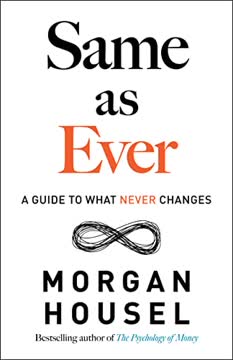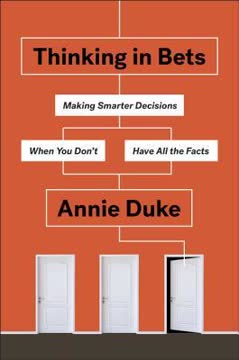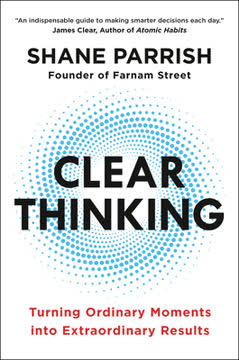Key Takeaways
1. The Map is Not the Territory: Understand the Limitations of Models
"Even the best maps are imperfect. That's because they are reductions of what they represent."
Models simplify reality. Maps and models are essential tools for understanding the world, but they are inherently flawed because they reduce complex systems into simpler representations. This simplification is both their strength and weakness. They help us navigate complexity, but can also lead us astray if we forget their limitations.
Recognize model limitations. To use models effectively:
- Understand the purpose and context of the model
- Be aware of what information is excluded
- Regularly update models based on new information
- Use multiple models to gain a more comprehensive understanding
Apply to decision-making. When using models to make decisions:
- Consider the model's assumptions and limitations
- Look for areas where the model may not accurately represent reality
- Be prepared to adjust your approach based on real-world feedback
2. Circle of Competence: Know What You Know and What You Don't
"Within our circles of competence, we know exactly what we don't know."
Identify your expertise. A circle of competence is the area where you have deep knowledge and experience. It's crucial to recognize both what you know well and what lies outside your expertise. This self-awareness allows you to make confident decisions within your circle and seek help or additional information outside of it.
Expand thoughtfully. To grow your circle of competence:
- Actively seek out new knowledge and experiences
- Practice applying what you learn
- Seek feedback from experts
- Be patient – building expertise takes time
Operate outside wisely. When you must work outside your circle:
- Acknowledge your limitations
- Seek advice from those with relevant expertise
- Use general mental models to guide your thinking
- Be extra cautious in your decision-making
3. First Principles Thinking: Break Down Complex Problems
"The real power of first principles thinking is moving away from random change and into choices that have a real possibility of success."
Start from fundamentals. First principles thinking involves breaking down complex problems into their most basic, foundational elements. This approach allows you to see past assumptions and conventional wisdom to find innovative solutions.
Apply the method:
- Identify and question your assumptions
- Break the problem down into its fundamental principles
- Create new solutions from those principles
- Test and refine your ideas
Overcome mental blocks. First principles thinking helps you:
- Challenge the status quo
- Find creative solutions to seemingly intractable problems
- Avoid getting stuck in outdated ways of thinking
- Build a deeper understanding of complex systems
4. Thought Experiments: Explore Possibilities Without Real-World Constraints
"Thought experiments tell you about the limits of what you know and the limits of what you should attempt."
Imagine the impossible. Thought experiments allow you to explore ideas and scenarios that would be impossible, dangerous, or unethical to test in reality. They are powerful tools for pushing the boundaries of our understanding and challenging our assumptions.
Conduct effective thought experiments:
- Clearly define your question or hypothesis
- Establish the parameters and rules of your imaginary scenario
- Mentally work through the scenario, considering all possible outcomes
- Analyze the results and draw conclusions
- Consider how your findings might apply to real-world situations
Apply across disciplines. Use thought experiments to:
- Explore scientific concepts (e.g., Einstein's elevator)
- Examine ethical dilemmas (e.g., the trolley problem)
- Test business strategies
- Challenge personal beliefs and biases
5. Second-Order Thinking: Consider the Consequences of Consequences
"If you don't consider 'the effects of the effects,' you can't really claim to be doing any thinking at all."
Look beyond immediate outcomes. Second-order thinking involves considering not just the immediate results of an action, but also the subsequent effects that may follow. This approach helps you make more informed decisions by anticipating potential long-term consequences.
Practice second-order thinking:
- Identify the immediate consequences of a decision
- Consider how those consequences might lead to further effects
- Evaluate potential unintended consequences
- Assess both short-term and long-term impacts
- Look for potential feedback loops or cascading effects
Apply to decision-making. Use second-order thinking to:
- Avoid unintended negative consequences
- Identify potential long-term benefits that may not be immediately apparent
- Make more strategic choices in complex situations
- Develop more robust plans and strategies
6. Probabilistic Thinking: Estimate Likelihoods for Better Decision-Making
"The degree to which our models accurately explain reality is the degree to which they improve our thinking."
Embrace uncertainty. Probabilistic thinking involves estimating the likelihood of different outcomes rather than seeking absolute certainty. This approach helps you make better decisions in complex, uncertain situations by considering a range of possible scenarios.
Key concepts in probabilistic thinking:
- Bayesian updating: Adjusting probabilities as new information becomes available
- Fat-tailed curves: Recognizing that extreme events may be more likely than we assume
- Asymmetries: Understanding that our probability estimates may be skewed
Apply probabilistic thinking:
- Identify the range of possible outcomes
- Estimate the likelihood of each outcome
- Consider the potential impact of each outcome
- Make decisions based on both probability and impact
- Update your estimates as new information becomes available
7. Inversion: Approach Problems from Multiple Angles
"Inversion shows us that we don't always need to be geniuses, nor do we need to limit its application to mathematical and scientific proofs. Simply invert, always invert, when you are stuck."
Flip the problem. Inversion involves approaching a problem from the opposite direction. Instead of focusing on how to achieve a goal, consider how to avoid failure. This technique can reveal new insights and help you identify potential pitfalls.
Apply inversion:
- State your goal or problem
- Flip it: What would cause the worst possible outcome?
- Identify actions or conditions that could lead to failure
- Develop strategies to avoid or mitigate those factors
- Use these insights to refine your approach to achieving your original goal
Benefits of inversion:
- Uncovers blind spots and potential risks
- Generates new perspectives on familiar problems
- Helps overcome cognitive biases
- Can lead to more robust, resilient solutions
8. Occam's Razor: Prefer Simpler Explanations
"If all else is equal, that is if two competing models both have equal explanatory power, it's more likely that the simple solution suffices."
Simplicity is powerful. Occam's Razor is the principle that, all else being equal, simpler explanations are more likely to be correct than complex ones. This heuristic helps us avoid overthinking and focus on the most probable solutions.
Apply Occam's Razor:
- Identify all plausible explanations for a phenomenon
- Evaluate the explanatory power of each hypothesis
- Compare the complexity of competing explanations
- Prefer the simplest explanation that adequately accounts for the evidence
- Remember that simplicity doesn't always mean correctness – continue to test and refine your understanding
Benefits of simplicity:
- Easier to test and falsify
- More likely to be understood and implemented correctly
- Often more elegant and insightful
- Helps avoid unnecessary assumptions and complications
9. Hanlon's Razor: Don't Attribute to Malice What Can Be Explained by Stupidity
"The explanation most likely to be right is the one that contains the least amount of intent."
Avoid assuming malice. Hanlon's Razor suggests that we should not attribute to malice what can be adequately explained by stupidity or ignorance. This principle helps us avoid unnecessarily negative interpretations of others' actions and promotes a more balanced worldview.
Apply Hanlon's Razor:
- When faced with a negative situation, identify possible explanations
- Consider explanations that don't involve intentional harm or malice
- Evaluate the likelihood of each explanation
- Choose the most probable explanation, favoring those with less assumed intent
- Respond based on this more balanced assessment
Benefits of applying Hanlon's Razor:
- Reduces unnecessary conflict and misunderstandings
- Promotes empathy and better communication
- Helps avoid paranoia and overly cynical thinking
- Allows for more constructive problem-solving approaches
Last updated:
FAQ
What's "The Great Mental Models: General Thinking Concepts, Vol. I" about?
- Purpose and Scope: The book, authored by Shane Parrish, aims to help readers develop a better understanding of how the world works by introducing them to mental models that enhance decision-making and problem-solving.
- Content Focus: It covers a range of topics including decision-making, learning, and the art of living, drawing on ideas from both science and the humanities.
- Project Ambition: This volume is part of a larger project to create a multidisciplinary education resource that is accessible to everyone, with plans for additional volumes covering various disciplines.
Why should I read "The Great Mental Models: General Thinking Concepts, Vol. I"?
- Improved Decision-Making: The book provides tools to help you make better decisions by understanding and applying mental models.
- Multidisciplinary Approach: It encourages thinking across different fields, helping you connect ideas and think in a more integrated way.
- Practical Application: The models are designed to be actionable, allowing you to apply them in real-life situations to avoid mistakes and spot opportunities.
What are the key takeaways of "The Great Mental Models: General Thinking Concepts, Vol. I"?
- Mental Models: Understanding and using mental models can significantly improve your thinking and decision-making processes.
- Latticework of Models: Building a network of interconnected models from various disciplines helps in understanding complex problems.
- Continuous Learning: The book emphasizes the importance of updating your knowledge and adapting your models as you gain new insights.
What is a mental model according to Shane Parrish?
- Definition: A mental model is a representation of how something works, simplifying complex realities into understandable chunks.
- Utility: They help in decision-making by allowing you to see problems from multiple perspectives and identify relevant information.
- Application: The book focuses on models with broad utility, which can be applied across various aspects of life and work.
How does "The Great Mental Models" suggest using first principles thinking?
- Core Idea: First principles thinking involves breaking down complex problems into their fundamental parts and building up from there.
- Techniques: The book suggests using Socratic questioning and the Five Whys method to identify and challenge assumptions.
- Innovation: By understanding the basic elements of a problem, you can create innovative solutions that are not bound by existing methods.
What is the Circle of Competence and how is it applied in the book?
- Concept: The Circle of Competence refers to understanding the boundaries of your knowledge and expertise.
- Self-awareness: It emphasizes the importance of knowing what you don't know and seeking help or learning in those areas.
- Decision-Making: Operating within your circle of competence leads to better decision-making and outcomes, while venturing outside requires caution and consultation.
How does the book explain the Map is not the Territory?
- Concept Explanation: This model highlights the difference between models or maps and the reality they represent, emphasizing that maps are simplifications.
- Limitations: It warns against mistaking the map for reality, as this can lead to errors in judgment and decision-making.
- Adaptability: The book stresses the need to update maps and models as the underlying reality changes.
What role does probabilistic thinking play in "The Great Mental Models"?
- Understanding Uncertainty: Probabilistic thinking helps in estimating the likelihood of various outcomes, improving decision accuracy.
- Bayesian Thinking: The book discusses Bayesian updating as a method to incorporate new information into existing knowledge.
- Fat-Tailed Curves: It also covers the concept of fat-tailed curves, which account for extreme events that can significantly impact outcomes.
How does "The Great Mental Models" address second-order thinking?
- Beyond Immediate Effects: Second-order thinking involves considering the long-term consequences of actions, not just the immediate effects.
- Avoiding Unintended Consequences: The book provides examples of how failing to consider second-order effects can lead to negative outcomes.
- Holistic Approach: It encourages a comprehensive view of decision-making, taking into account the broader system and potential ripple effects.
What is the significance of Occam's Razor in the book?
- Simplicity Preference: Occam's Razor suggests that simpler explanations are more likely to be correct than complex ones.
- Decision-Making Tool: The book uses this principle to guide decision-making, helping to avoid unnecessary complexity.
- Efficiency: By focusing on simpler explanations, you can save time and resources, making more efficient decisions.
How does the book use inversion as a thinking tool?
- Reverse Thinking: Inversion involves approaching problems from the opposite end, considering what you want to avoid rather than achieve.
- Problem-Solving: This method helps identify obstacles and potential pitfalls, allowing for more effective solutions.
- Practical Examples: The book provides examples of how inversion can lead to innovative solutions and better decision-making.
What are the best quotes from "The Great Mental Models" and what do they mean?
- "The quality of your thinking depends on the models that are in your head." This quote emphasizes the importance of mental models in shaping how we perceive and interact with the world.
- "Understanding only becomes useful when we adjust our behavior and actions accordingly." It highlights the need to apply knowledge in practical ways to effect positive change.
- "The map is not the territory." This quote serves as a reminder that models are simplifications and should not be confused with reality.
Review Summary
The Great Mental Models receives mixed reviews. Many praise its accessible introduction to mental models for improved thinking and decision-making, with some considering it essential reading. Critics argue the content is basic and lacking depth. Readers appreciate the book's design and examples but note repetition and narration issues in the audiobook. Some find it incomplete as the first in a series. Overall, reviewers value the concept but have varying opinions on execution, with some recommending only specific chapters or suggesting alternative resources.
Similar Books










Download PDF
Download EPUB
.epub digital book format is ideal for reading ebooks on phones, tablets, and e-readers.







